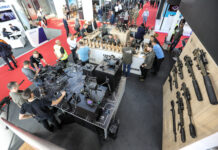The Republic of Korea Navy (ROKN) is now deploying its third generation of domestically produced conventional submarines (SSK). As this article will show, the ROKN’s first-generation SSK was a foreign acquisition that evolved into an SSK produced under licence in the Republic of Korea (ROK).
The ROK would go on to take the knowledge gained from this first-generation SSK to offer refit services to export customers and later offer new-build submarines based on this SSK design to export customers. The first-generation SSK provided an operational capability for the ROKN, equally as important was that it provided the foundations for an indigenous SSK build capability and created the basis for an industrial SSK ecosystem covering everything from subsystems to naval weapons.
What is impressive here is how rapidly the ROK has developed operational and industrial capabilities in the SSK arena. The first-generation SSK was ordered in 1987, 36 years ago, and was commissioned into the ROKN in 1993, 30 years ago. In that time, the ROK has built and commissioned the first-generation SSK and then undertaken a locally defined and managed upgrade and modernisation programme on those SSKs. It then looked overseas for a design to meet its second-generation SSK requirements, a programme known as KSS-II. A far more sophisticated SSK than the first-generation boat, the KSS-II again saw local production and technology transfer.
The first- and second-generation SSK programmes provided operational and sustainment experience for the ROKN. They also provided the industrial and programme management experience necessary to contemplate a third-generation SSK. In fact, during the 1990s, as the ROKN transitioned to becoming a true ‘Blue Water Navy’,’they were defining a force structure plan for the 2020s that included many of the characteristics of the KSS-III we see today. KSS-III requirements included a larger displacement, long endurance for extended range operations and the ability to support a form of strategic land attack capability to deter the Democratic People’s Republic of Korea (DPRK).
Starting Points
In 1948, after the establishment of the ROK as an independent state and the ending of Allied occupation, the ROKN was formed out of the Korean Coast Guard. The ROKN saw its first combat action upon the outbreak of the Korean War (1950-1953), while during the rest of that conflict it worked with US and Allied navies, establishing maritime dominance around the Korean peninsula. After the armistice that ended hostilities, the ROKN mission was primarily coastal patrol, with equipment acquired from the US, much of it surplus.
With the ROK economic situation improving, the government was able to embark on the ‘Yulgok Plan’ to increase self-reliance via the establishment of a national defence industry.
he ROKN would benefit from this policy, initially sourcing patrol units from local shipyards. However, while the ROKN was gradually building its capabilities, its primary strategic competitor and threat, the DPRK Navy was starting to significantly upgrade its own capabilities. In the 1970s, the DPRK acquired seven Type 033 Romeo class SSKs from China and it would then go on to build additional submarines, assembling parts supplied from China.
All of a sudden, the ROKN found itself with an anti-submarine warfare (ASW) mission to add to its primary patrol and coastal defence tasks. As a counter to the DPRK’s expanding capabilities and due to the growing maturity of the ROK’s naval shipbuilding, the ROKN was able to field frigate and corvette classes of local design, but equipped with foreign weapons and systems, throughout the 1980s.
During this period, the ROKN was already working on defining a future structure that would expand its operational capabilities. Part of this structure would involve the possession of an SSK force, achieving that objective would require a great deal of research, and to that end, the Korea Tacoma shipyard was contracted to build the first Dolgorae class midget submarine. This vessel had a displacement of 175 tonnes, a crew of 14, two torpedo tubes and major subsystems from Germany and Britain. The lead unit was launched in 1982 and commissioned in 1985, before being retired in 2003. Two more units were commissioned in the early 1990s, and these remained in service until retired in 2016. The Dolgorae provided a training capability for future ROKN submariners, and it played a role in improving the ASW skills of ROKN surface units. Midget submarines are also very useful in carrying out special missions, with the ROKN continuing to flirt with units of this nature over the years. However, it was the DPRK Navy which ended up developing a more comprehensive midget submarine capability.
The First Generation
The decision to acquire a full SSK for the ROKN had two dimensions; firstly, they wanted to acquire the best system for their operational environment. Secondly, they wanted to develop a capability to build and sustain SSKs, with the eventual objective of having the ability to design and build indigenous SSKs in ROK yards. With the US not having the ability to offer an SSK design, this offered the ROK the opportunity to evaluate the full spectrum of European SSK proposals. Added to which, the opportunity to increase national capability while reducing dependence on the US, was an equally welcome development.
In the 1980s, Europe could offer a profusion of national SSK designs, as in parallel, most of the European nations had the supporting industrial base for all critical submarine systems and subsystems. This offered the ROK the ability to acquire expertise and technology from multiple sources. After evaluating their options, the ROKN turned to Howaldtswerke-Deutsche Werft (HDW), now thyssenkrupp Marine Systems, and the Type 209 submarine design in the Type 209/1200 variant.
The first batch of three submarines was ordered in 1987, with the lead ship of the class built in Germany and commissioned as the ROKS Jang Bogo (SS 061) in June 1993. As an aside, this unit was often referred to as the Chang Bogo, changes in the transliteration of Korean to English led to it being referred to as the Jang Bogo. The second and third units were assembled in the ROK at the Daewoo Shipbuilding and Marine Engineering (DSME) yard at Okpo. ROKS Yi Cheon (SS 062) was commissioned in June 1994 and ROKS Choe Museon (SS 063) in February 1995.

Credit: US Navy
Batch II vessels of the Jang Bogo class were built at DSME; these were ROKS Park Wi (SS 065) commissioned in August 1995, ROKS Lee Jongmoo (SS 066) in August 1996 and ROKS Jung Woon (SS 067) in August 1997. The third batch units have additional capabilities as they can launch UGM-84A sub-Harpoon missiles, in addition to the SUT torpedoes that are standard fit. Batch III, all built at DSME, consists of ROKS Yi Sun-sin (SS 068) commissioned in February 2000, ROKS Na Dae Yong (SS 069) in December 2000, and ROKS Yi Eokgi (SS 071) in December 2001.
A refit and upgrade programme has added significant performance improvements and new capabilities to the Jang Bogo class, as well as extend service life. These are said to include an increase in displacement akin to the Type 209/1400, improved high performance batteries of ROK design, new combat management system, towed array sonar, indigenous torpedo countermeasures system and new weapon options, including the ROK heavyweight torpedo. In June 2017, ROKS Na De Yong began a refit at DSME, with the SSK returning to the ROKN service on 10 June 2019.
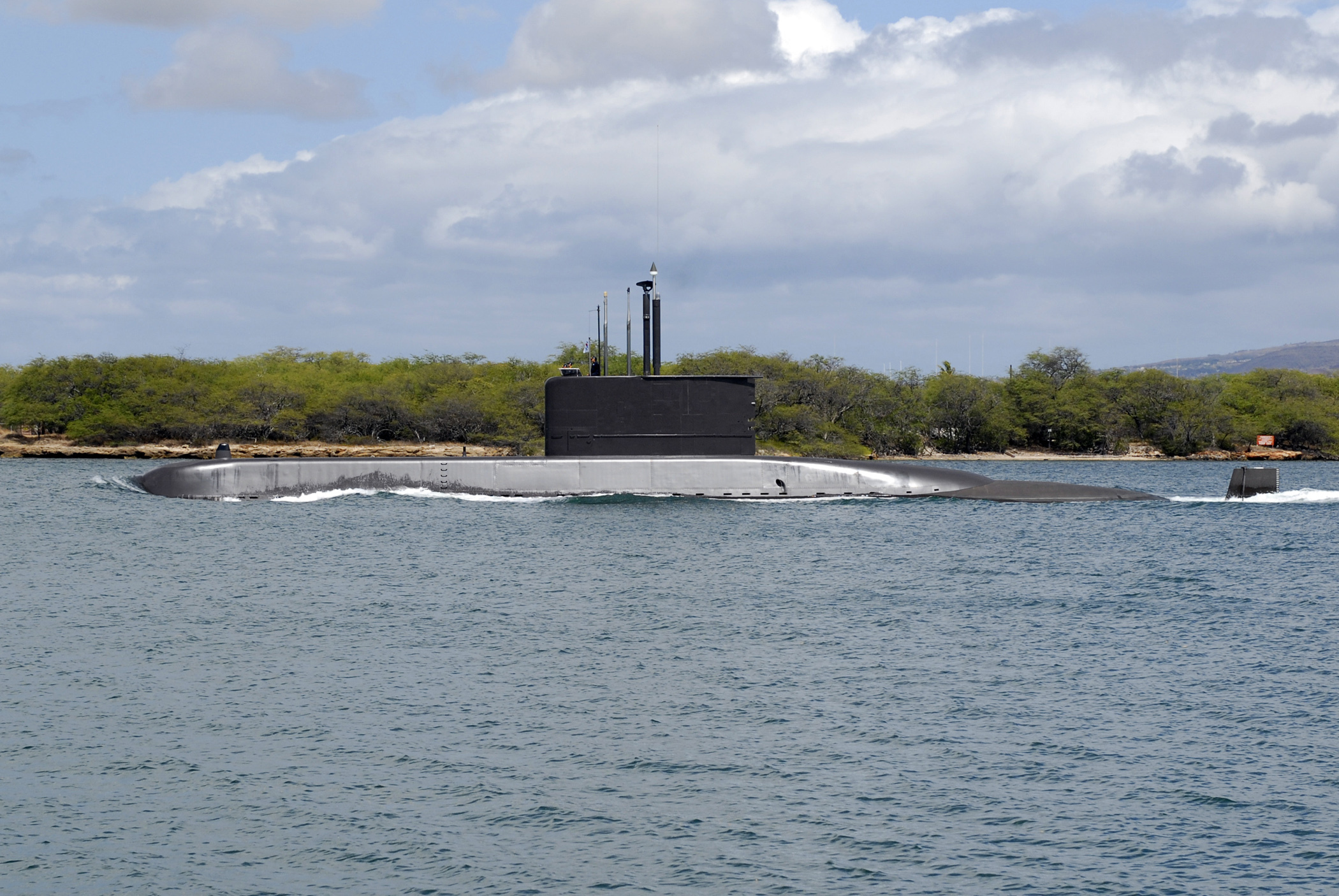
Credit: US Navy
Export Success
That DSME had mastered the art of submarine construction was proven in 2011 when they received an export order from Indonesia for three submarines. It might surprise many, but the first Asian country to export submarines was actually Japan, which supplied four Matchanu class submarines, built by Mitsubishi Heavy Industries to Thailand. The first two vessels were delivered in September 1937 and the second two in April 1938.
Since the 1970s, the Asian submarine export market has been dominated by China. Its first major programme was the supply of 20 Type 033 Romeo class SSKs to the DPRK, with the majority assembled or built in the DPRK; China also supplied eight Romeo class boats to Egypt. Also exported were ex-PLA Navy Type 035 Ming class SSKs with Bangladesh receiving two and Myanmar receiving one.
More recently, PLA Navy and Chinese submarine designs have massively increased in quality and capability. Latest generation SSK designs such as the upgraded Type 039B have been sold to Pakistan, with eight units ordered. Thailand has also opted for Chinese submarines in the form of the S26T export model, though funding has proven problematic here. The objective was to acquire a minimum of three boats, but currently only one has been contracted. Even the DPRK has exported a submarine in the shape of a Yono class midget submarine sold to Iran.
ROK submarine links with Indonesia started when DSME won a refit contract for Cakra, a Type 209/1300 class boat built by HDW and commissioned into the Indonesian Navy (TNI-AL) in March 1981. The refit and overhaul for Cakra was completed in 2005, but due to financial issues in Indonesia, a refit for sister ship Nanggala was postponed, with the vessel eventually being completed in early 2012.
The TNI-AL had been looking to add to its SSK capabilities for many years, but was unable to find a solution until the ROK offered a package of three submarines, two to be built by DSME in the ROK and a third to be assembled by the PT PAL shipyard in Surabaya, Indonesia. The units in question are an evolution of the Type 209/1400 design, based on the Jang Bogo ROKN upgrade with the addition of Indonesia-specific systems. The contract was finalised in December 2011. Lead unit KRI Nagapasa (403) was commissioned in August 2017, and she was followed by KRI Ardadedali (404) commissioned in April 2018. KRI Alugoro (405), the unit assembled in Indonesia, was commissioned in April 2021.
A contract for a second batch of three Nagapasa vessels was agreed in April 2019, with the first unit to be assembled at PT PAL and the other two to be built at PT PAL. The contract has not come into force and there are doubts that it ever will, especially since the French defence relationship with Indonesia has become very close recently and interest has been shown in the Scorpène SSK design. With Indonesia’s defence procurement process being so changeable, absolutely anything could happen regarding an SSK requirement, or perhaps even nothing at all!
The Second Generation
The second generation of ROKN submarines were acquired under the KSS-II programme. The drivers for KSS-II were, once more, both operational and industrial. For the ROKN, they were looking for a boat that offered increased operational endurance and range, hence the necessity for an effective air independent propulsion (AIP) system. Inevitably, the KSS-II would be more sophisticated than the previous generation SSK and considerably more survivable in contested environments.
Industrially, KSS-II would introduce the ROK to advances in submarine technology that could be applied to a future indigenous submarine programme. Due to the fact that the ROKN envisaged having and sustaining a large SSK fleet, in excess of 20 units, they could justify having a second build yard and for that reason Hyundai Heavy Industries (HHI) was selected to be the lead yard for the KSS-II programme.
In 2000, HDW was selected as the winner of the KSS-II programme with its Type 214 submarine. The lead unit, ROKS Sohn Won-yil (SS 072) was laid down at HHI in June 2006 and commissioned in December 2007. The second unit, ROKS Jeong Ji (SS 073), was commissioned in December 2008, with the third unit of Batch I, ROKS An Jung-geun (SS 075) commissioned in December 2009.
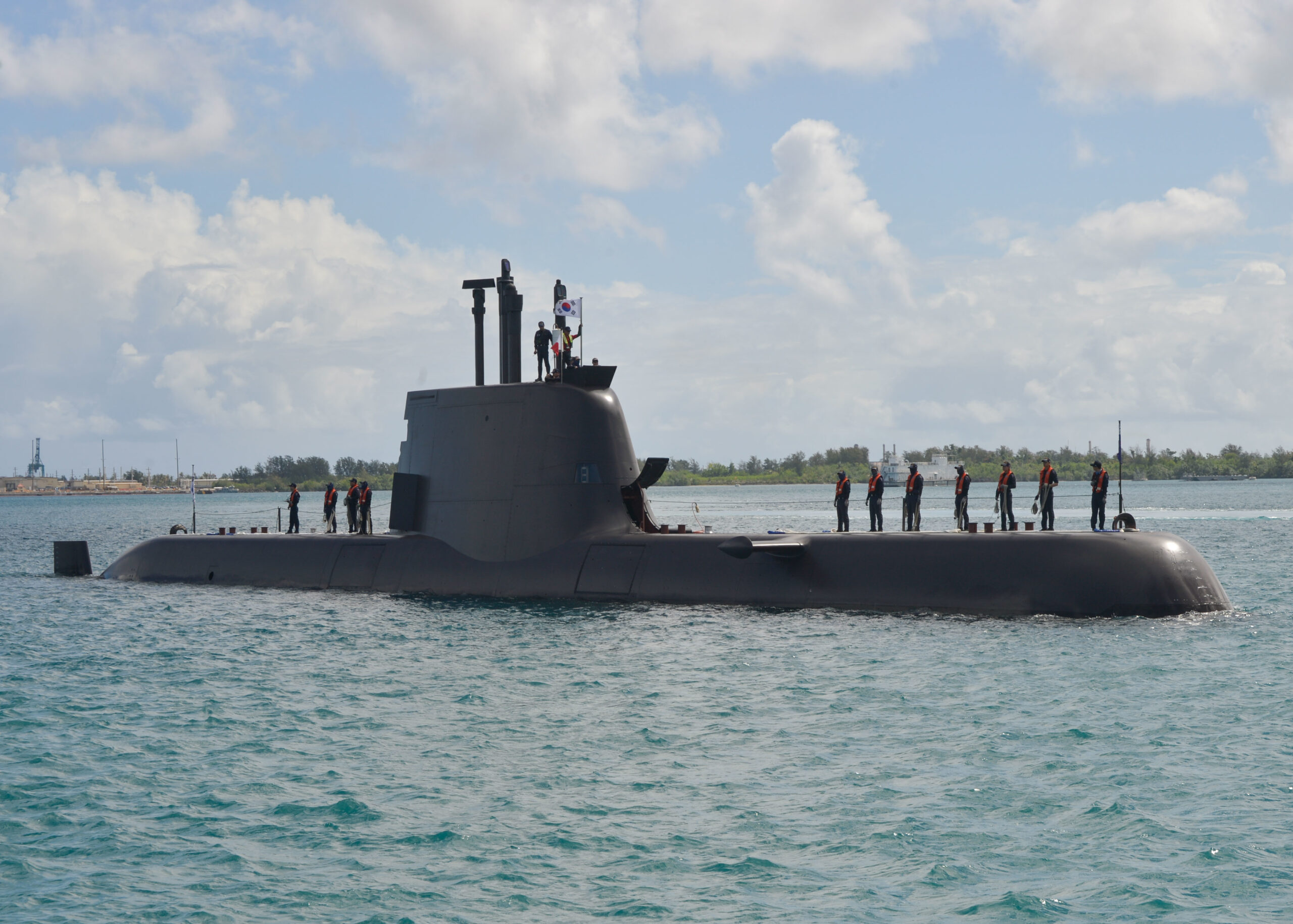
Credit: US Navy
KSS-II Batch II vessels were contracted in 2006, with the first unit, ROKS Kim Jwa-jin (SS 076), built at DSME and commissioned in December 2014. The second unit, ROKS Yong-Bong-gil (SS 077), was built at HHI and commissioned in June 2016, followed by ROKS Yu Gwan-sun (SS 078), built at DSME and commissioned in July 2017. The remaining three boats were: ROKS Hong Beom-do (SS 079), built at HHI and commissioned in January 2018; ROKS Lee Beom-seok (SS 081), built at DSME and commissioned in May 2019, and ROKS Shin Doi-seok (SS 082), built at HHI and commissioned in January 2020. ROKS Hong Beom-do was reportedly used for the test and integration of the indigenous Haeseong III (Hyunmoo-3A) submarine-launched cruise missile on the KSS-II class and for the future KSS-III class.
The KSS-II programme provided the basis for work to commence on the KSS-III programme for a truly indigenous ROK submarine and as previously discussed, KSS-II also allowed the ROK to have two shipyards capable of building SSKs. The first and second-generation submarines for the ROK were a learning process for the ROKN. For ROK industry, KSS-III would determine if this learning process had been a success.
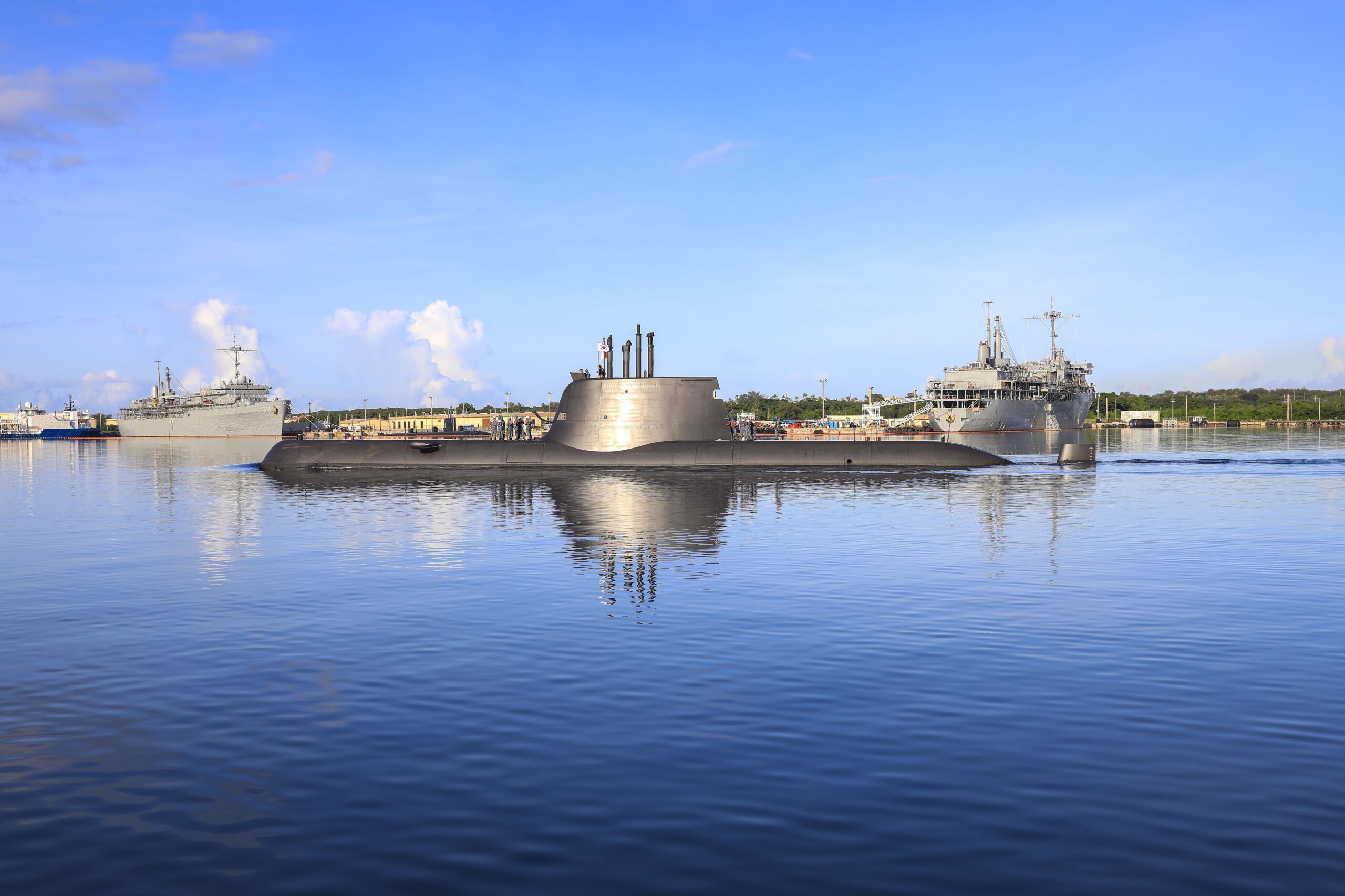
Credit: US Navy
The Third Generation
When the ROK started developing the KSS-III programme, its operational requirements were far more multi-layered than before. Having become a true ‘Blue Water Navy,’ the ROKN saw its operational area grow far beyond the waters surrounding the Korean peninsula. At this point, the ROK had become a top ten global economy, further opening up the requirements to operate at an extended range from ROK homeports. The ROKN began to define its operational area of interest from the eastern coast of Africa to the western coasts of the Americas.
The ROKN also had to take into account the evolution of the various threats that it would have to consider. For historical reasons, the ROK always has to keep a wary eye on Japan, plus there are disputes over maritime boundaries between Seoul and Tokyo to consider. Realistically though, Japan does not present a threat of any magnitude. In the past, the ROKN would have been concerned with the Soviet Navy and later with its successor, the Russian Navy, primarily due to Moscow’s support to the DPRK. These days, the Russian Pacific fleet is a shadow of its former self and does not represent a top tier threat to the ROK.
The growth of Chinese maritime power has undoubtedly become a source of concern for the ROK, as has China’s ongoing linkages with the DPRK. China therefore has moved to a prime position in the ROK threat calculus. That brings us to the DPRK which continues to be an existential threat to ROK security. DPRK nuclear and other Weapons of Mass Destruction (WMD), along with a profusion of delivery systems, are an obvious ongoing threat to the ROK.
In a maritime context, the DPRK Navy also represents a constant and evolving threat. In March 2014, the Gorae class SSK 8.24 Yongung was launched with the capacity to launch a single Submarine-Launched Ballistic Missile (SLBM). The Gorae class appears to be a test unit for the development of the DPRK SLBM capability rather than an operational system.
The lead unit of the new Sinpo-C class submarine was completed in August 2020, and appears to be the operational SLBM system. The Sinpo-C, a conventional SSK, is estimated to have a displacement in the region of 3,000 tonnes and is thought to have an AIP capability able to carry either three or four SLBMs. The SLBM is thought to be the Pukguksong-3, which is believed to have a 1,900 km range; no information is available on the warhead, although a nuclear payload would not be unexpected.
Then there is the DPRK SSK threat to take into consideration. There are more than 40 Sang-O and Sang-O II class coastal submarines in service, plus the survivors of the Type 033 Romeo class, acquired and built between the 1970s and 1990s, although the latter are obsolete and far too noisy. Then there are at least 20 DPRK mini submarines to take into account as well. This SSK threat has to be considered, hence the ROK investment in Maritime Patrol Aircraft (MPA), surface ship and submarine-based ASW mission capabilities.
As far as the KSS-III was concerned, these DPRK developments led to the mission spectrum of the boat being significantly expanded. Initially KSS-III was envisaged as an SSK that had the ability to perform a mission akin to that of an SSN. The mission would be hunting down hostile SSKs, attacking surface targets as required and conducting land attack missions using indigenous cruise missiles.
Once it became clear that the DPRK was deploying an SLBM capability, the ROK had to respond and decided to field its own SLBM capability in the shape of the Hyunmoo-4.4. This is said to be a development of the land-based Hyunmoo-2B, with a range of 500 km and a warhead in the 1,000 kg category. In September 2021, the lead KSS-III unit, ROKS Dosan Ahn Chang-ho (SS 083), built by DSME and commissioned in August 2021, performed two Hyunmoo-4.4 launch tests on 7 and 15 September.
To digress slightly, it should be noted that the ROK has a strong civil nuclear power capability. For example, it has exported nuclear power stations to the United Arab Emirates (UAE). Should the ROK Government be prepared to take the risk, there is no reason why they could not develop a nuclear weapons capability. Equally, given some external assistance, they could develop a submarine nuclear propulsion system as the basis for an SSN. As things stand though, the ROK has resisted pursuing the nuclear option.
The KSS-III is now referred to as the Jang Bogo-III class, but also by the name of the lead unit Dosan Ahn Chang-ho. The first three boats are referred to as Batch I units, with the second boat to be launched being ROKS Ahn Mu (SS 085) in November 2020 at DSME. The third boat, ROKS Shin Chae-ho (SS 086) was launched at HHI in December 2021. At the launch of ROKS Ahn Mu, the ROK Defense Acquisition Program Administration (DAPA) released details on the Batch I boats. They noted that the submarine has 76% local content; surface displacement is 3,358 tonnes and displacement submerged is 3,705 tonnes, Its length is given as 83.5 metres and a beam of 9.6 metres. They also stated that the SSK has six VLS cells for the launch of the Hyunmoo-4.4 SLBM. The second unit will commission this year and the third in 2024.
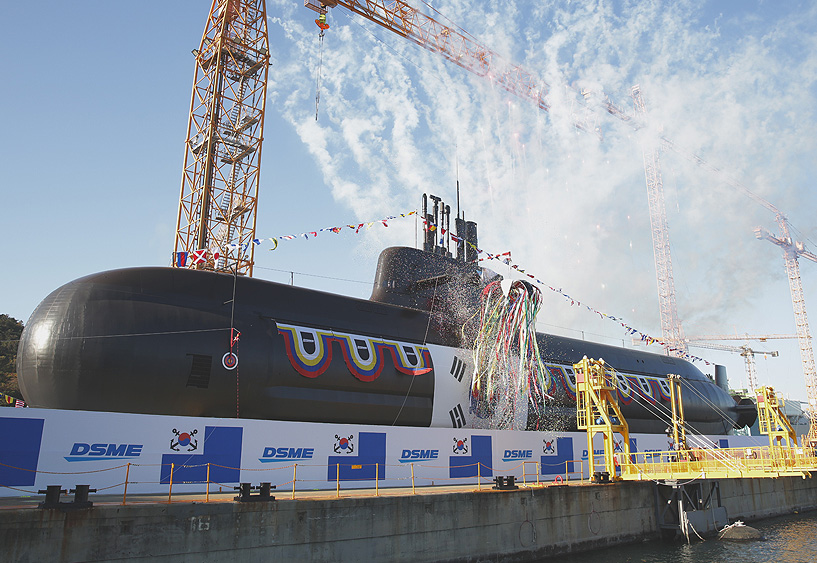
Credit: DSME
The first Batch II unit, ROKS Lee Bong-chang (SS 087) is under construction at DSME, with likely commissioning in 2027, with the yard also awarded a contract to start work on an as yet unnamed second Batch II unit. Batch II submarines will have a larger displacement and length, with ten VLS cells for the Hyunmoo-4.4 SLBM. Local content in the Batch II boats has been increased to 80%, with the most significant local addition being the inclusion of lithium-ion (Li-ion) batteries. Compared to conventional SSK batteries, Li-ion batteries offer greater endurance, a significant increase in battery life and an increase in recharging cycles prior to replacement. Current planning calls for three Batch II units to be built, followed by three Batch III units. At this point, there is no information available on possible configuration differences on the Batch III boats.
The KSS-III design and its associated technology also provide the basis for export submarine designs offered by DSME, in the form of the DSME-2000 and the larger DSME-3000, with the number representing the displacement of the submarine. The initial export target for DSME is the highly competitive Indian Navy SSK requirement. With its mix of ROK and European technology, these advanced submarine designs could well be a very credible proposition in future SSK export markets. All told, the ROK has come a long way in SSK development terms since the 1980s.
David Saw



